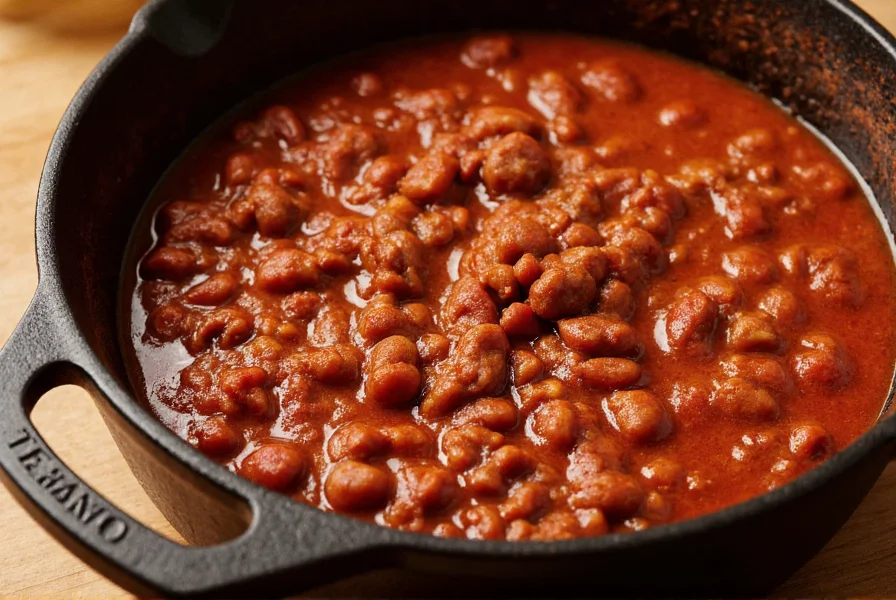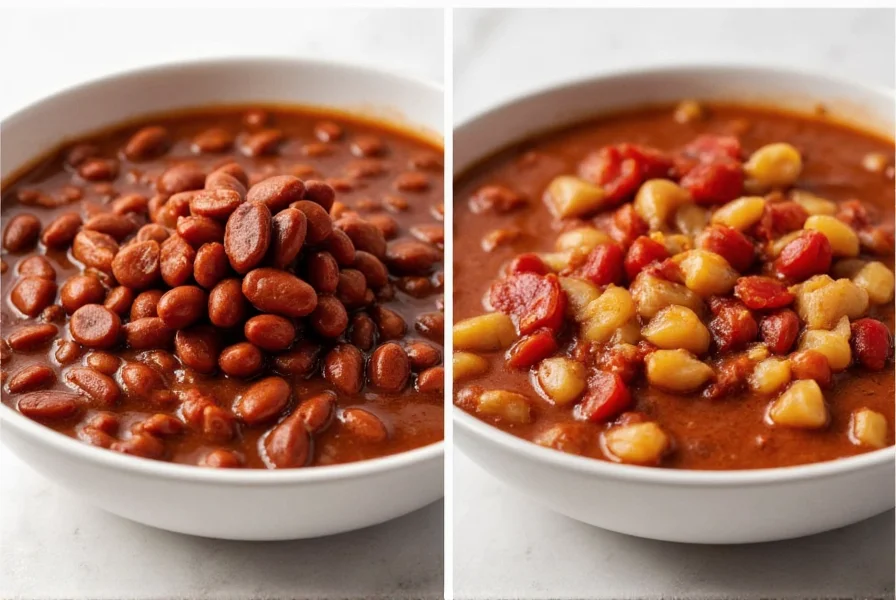Traditional Texas-style chili does not contain beans. Authentic chili con carne, originating from Texas and Northern Mexico, is made with meat, chilies, and spices only. However, many modern variations across the United States do include beans, creating a longstanding culinary debate.
When you ask does chili have beans, you're touching on one of America's most enduring food controversies. The simple answer is: it depends on who's making it and where. Understanding this question requires exploring chili's rich history, regional variations, and evolving culinary traditions.
The Origins of Authentic Chili
Chili con carne ("chili with meat") traces its roots to the cowboys and settlers of Texas and Northern Mexico in the 19th century. These early versions contained just three essential components: meat (typically beef), dried chilies, and spices. Beans were notably absent from these traditional preparations.
The absence of beans wasn't an oversight but a practical necessity. Cowboys needed lightweight, non-perishable ingredients they could carry on cattle drives. Dried chilies, spices, and salted meat met these requirements, while beans would have required additional cooking time and water—resources often in short supply on the trail.
Regional Variations Across America
As chili spread across the United States, regional interpretations emerged. The inclusion of beans became common outside Texas, particularly in Midwestern and Eastern states. This divergence created two distinct chili cultures that continue to this day.
| Chili Style | Region | Beans Included? | Key Characteristics |
|---|---|---|---|
| Texas Red | Texas | No | Meat-focused, rich broth,多种辣椒混合 |
| Cincinnati Chili | Ohio | Sometimes | Served over spaghetti, Mediterranean spices |
| New Mexico Style | New Mexico | No | Green chili base, often without tomatoes |
| Midwestern Chili | Middle America | Yes | Bean-heavy, often with tomatoes |
The Great Beans Debate
The question why do some people not put beans in chili reveals deep culinary philosophy. Traditionalists argue that beans dilute the rich meat and chili pepper flavors that define authentic chili. They view beans as filler that transforms chili from a robust meat stew into a different dish entirely.
Conversely, bean proponents note practical advantages: beans add protein, fiber, and heartiness while reducing costs. During economic hardships like the Great Depression, beans became common chili ingredients as families stretched limited meat supplies. This practical adaptation became tradition in many households.

Chili Con Carne vs. Modern Chili
Understanding the difference between chili and chili con carne clarifies much of the confusion. Authentic "chili con carne" specifically refers to the bean-free Texas style. When people say simply "chili" today, they might mean any spicy meat (or vegetarian) stew, with or without beans.
The International Chili Society, which hosts competitive chili cook-offs, maintains strict categories:
- Traditional Red Chili - No beans allowed
- Homestyle Chili - Beans permitted
- Chili Verde - Green chili version, no beans
This distinction shows how seriously competitive chili makers take the beans question. In traditional competitions, adding beans would immediately disqualify your entry.
Modern Interpretations and Dietary Adaptations
Today's culinary landscape features endless chili variations. Vegetarian and vegan chili almost always includes beans as a protein substitute. Health-conscious versions might use beans for their fiber content. Regional grocery chains often stock both bean-containing and bean-free options to satisfy different customer preferences.
When asking is it wrong to put beans in chili, the answer depends on context. For authentic Texas-style preparation, yes—it's considered incorrect. But for personal cooking or regional styles, beans are perfectly acceptable. Food traditions evolve, and what matters most is creating a dish you enjoy.

What to Expect When Ordering Chili
If you're wondering what is chili supposed to have in it when dining out, regional expectations vary significantly:
- In Texas: Don't expect beans unless specifically advertised as "chili with beans"
- In the Midwest: Beans are the norm, and bean-free chili might be labeled "Texas-style"
- Nationally: Restaurant menus often specify whether beans are included
When making chili at home, consider your audience. For a crowd that includes chili purists, prepare a bean-free version separately. Most chili enthusiasts agree that respect for different traditions makes the chili community richer.
Conclusion
The question does chili have beans doesn't have a single definitive answer—it depends on tradition, region, and personal preference. Authentic Texas chili con carne contains no beans, while many other regional variations proudly include them. Understanding this distinction helps navigate both culinary history and modern cooking practices.
Whether you prefer your chili with or without beans, appreciating the historical context and regional diversity enriches your experience of this beloved American dish. The most important ingredient in any chili remains the care with which it's prepared and shared.
Frequently Asked Questions
Why don't Texans put beans in chili?
Texans traditionally omit beans from chili for historical reasons. Early Texas chili was made by cowboys who needed lightweight, non-perishable ingredients for cattle drives. Beans required additional cooking time and water—resources often scarce on the trail. This practical adaptation became culinary tradition, with Texas chili focusing on the pure flavors of meat and chilies.
Is chili with beans authentic?
Chili with beans is authentic to many regional American traditions, particularly in the Midwest and Eastern United States, though not to the original Texas-style chili con carne. While traditional Texas chili contains no beans, bean-inclusive versions became popular during the Great Depression when families stretched limited meat supplies. Both styles have legitimate places in American culinary history.
What can I use instead of beans in chili?
If you're making traditional Texas-style chili without beans, you can enhance texture and nutrition with alternatives like diced potatoes, lentils, or extra vegetables such as bell peppers and onions. Some cooks add a small amount of masa harina for thickening and traditional flavor. For vegetarian versions, mushrooms, textured vegetable protein, or extra grains like quinoa can provide substance without beans.
Does Cincinnati chili have beans?
Traditional Cincinnati chili typically does not contain beans. This unique regional style, served over spaghetti with specific topping combinations ("ways"), focuses on a thin, Mediterranean-spiced meat sauce. While some modern variations might include beans, authentic Cincinnati chili follows the bean-free tradition similar to Texas-style, though with completely different flavor profiles.
Can I call it chili if it has beans?
Yes, you can call it chili if it has beans—many regional American styles do. While traditional Texas chili con carne contains no beans, "chili" as a broader category includes numerous variations. Most grocery stores sell both "chili with beans" and "chili without beans." The key is to be clear about what style you're making or serving, as expectations vary regionally across the United States.











 浙公网安备
33010002000092号
浙公网安备
33010002000092号 浙B2-20120091-4
浙B2-20120091-4